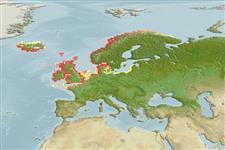Environment: milieu / climate zone / depth range / distribution range
Ökologie
seewasser demersal; standorttreu; tiefenbereich 0 - 30 m (Ref. 35388). Temperate; 77°N - 48°N, 25°W - 45°E
Northeast Atlantic: North Sea, around the British Isles, Norwegian Sea, southwestern Barents Sea and around southern Iceland.
Size / Gewicht / Alter
Maturity: Lm ? range ? - ? cm
Max length : 15.5 cm TL Männchen/unbestimmt; (Ref. 106276)
Kurzbeschreibung
Morphologie | Morphometrie
No overlap of dorsal and caudal fins, but rarely overlapping anal and caudal fins (Ref. 35388).
Occurs from intertidal to 30 m, often under stones or clinging to algae. Feeds primarily on crustaceans; gammarid amphipods in intertidal; shrimps and small crabs in subtidal areas. Spawns in winter; young are also found in the Wadden sea (Ref. 35388).
Eggs are deposited on algae or polyp colonies.
Wheeler, A., 1992. A list of the common and scientific names of fishes of the British Isles. J. Fish Biol. 41(suppl.A):1-37. (Ref. 5204)
IUCN Rote Liste Status (Ref. 130435)
Bedrohung für Menschen
Harmless
Nutzung durch Menschen
Fischereien: nicht kommerziell
Mehr Information
ReferenzenAquakulturAquakultur ProfilZuchtlinienGenetikElectrophoresesVererbbarkeitKrankheitenVerarbeitungNutrientsMass conversion
PartnerBilderStamps, Coins Misc.LauteCiguateraGeschwindigkeitSchwimmstilKiemenoberflächeOtolithsGehirngrößeSehfähigkeit
Tools
Zusatzinformationen
Download XML
Internet Quellen
Estimates based on models
Preferred temperature (Ref.
123201): 7.8 - 12.3, mean 10.1 °C (based on 433 cells).
Phylogenetic diversity index (Ref.
82804): PD
50 = 0.5000 [Uniqueness, from 0.5 = low to 2.0 = high].
Bayesian length-weight: a=0.00724 (0.00394 - 0.01332), b=3.18 (3.02 - 3.34), in cm total length, based on LWR estimates for this species & (Sub)family-body (Ref.
93245).
Trophic level (Ref.
69278): 3.5 ±0.57 se; based on food items.
Widerstandsfähigkeit (Ref.
120179): mittel, Verdopplung der Population dauert 1,4 - 4,4 Jahre. (Fec=793).
Fishing Vulnerability (Ref.
59153): Low vulnerability (10 of 100).
Nutrients (Ref.
124155): Calcium = 110 [52, 239] mg/100g; Iron = 0.527 [0.253, 1.028] mg/100g; Protein = 17.1 [15.6, 18.5] %; Omega3 = 0.601 [0.242, 1.734] g/100g; Selenium = 10.5 [4.6, 26.2] μg/100g; VitaminA = 19.8 [5.2, 70.7] μg/100g; Zinc = 0.799 [0.537, 1.196] mg/100g (wet weight);
